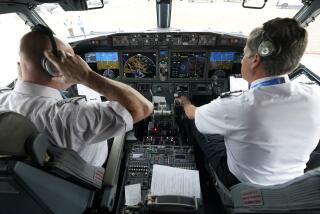
- Share via
I’ve always been a nervous flier. The second I take my assigned seat in a plane, I pull my headphones over my ears and glue my eyes shut in an attempt to drown out the sound of a plane taking off.
The tactic usually works, but with the recent fatal midflight collision at Reagan National Airport followed by an air ambulance crash in Philadelphia and a fiery plane engine evacuation in Houston, my anxiety has been off the charts.
Research shows that up to 40% of the population reports some degree of flight anxiety. Given the recent string of incidents, experts say it’s understandable that those with flight anxiety would feel more on edge than usual.
Researchers at UC Berkeley say a daily 20-second ‘micropractice’ can help reduce stress and improve mental health.
“The odds of something happening don’t matter as much to the anxious brain,” said Andrea Bonior, a teaching professor in Georgetown University’s department of psychology. “The anxious brain is drawn in by the horrific stakes of something.”
So how should you approach your next flight? Here are five tips to ease your mind before takeoff.
1. Know the facts
Despite recent headlines, the old adage “you have a greater chance of dying in the car on the way to the airport than on a flight from the airport” remains true (even if it is crass). Commercial airliners are the safest plane for passengers, aviation experts told The Times. Unlike for smaller aircraft, pilots must achieve the highest certification, an airline transport pilot certification, to command commercial planes, said Thomas Anthony, the director of the USC Aviation Safety and Security Program. Plus, all commercial aircraft are routinely inspected and maintained by the Federal Aviation Administration and fly within a regulated air traffic control system.
A pilot’s biggest fear is a midair collision, said Martin O’Loughlin, the president and chief operating officer of Cornerstone Aviation, an FAA-authorized flight school in Utah. But he said it’s important to remember that midair collisions make such big news, in part, because they’re extremely rare.
“In almost every case, the design of the airspace and the rules that the FAA uses to design arrivals and departures is very, very good,” said O’Loughlin, while acknowledging that more planes flying than ever before and fewer air traffic controllers has put a strain on the industry.
“It’s really hard to build an impenetrable wall against our fears, but you don’t have to latch onto those fears and dwell on them either,” he added.
In “Beyond Anxiety,” Martha Beck argues that discovering your creative calling is the antidote to an anxious existence.
2. Visualize
Just as a star athlete visualizes their performance before game time, envisioning your flight — potential turbulence and all — can help ease your anxiety before the journey has even begun.
Be honest with yourself about whether you are a catastrophizer or someone who can roll with the punches, said Steven Siegel, the chair of the department of psychiatry and the behavioral sciences at the Keck School of Medicine of USC. If you’re the former, going into the plane expecting how you might feel in a seatbelt-sign-on situation can deflate your anxiety and help you be less hard on yourself when you do feel anxious, said Bonior. Plus, it can be harder to mitigate anxiety in the heat of the anxious moment.
In addition to visualizing, you can plan to bring soothing aides such as fidget spinners or essential oils. You can also download audio meditations or mantras to get you through the flight. Some free options include Healthy Minds Program and, for younger people, the Smiling Mind.
3. Slow your thoughts
Anxiety may be experienced as a partially physiological pathway, said Lauren Ng, an assistant professor of clinical psychology at UCLA. For example, thoughts lead to physiological responses such as trembling hands. That can then lead to behaviors such as avoidance. Which is then how you arrive at feelings like fear.
To disrupt the first part of this pathway, try to halt the hamster wheel in your head. Then, if you’re a logical person, you can remind yourself of the facts. Ask yourself: What is the actual thought driving this fear? Is this thought accurate?
If logic is less your thing, turn to mindfulness, which is the practice of being aware of your thoughts and then letting them pass on. Mindfulness can look like meditation or prayer depending on the person. The idea is to accept that the fear is there but to not ruminate over, or attach to, it.
A new study from the Salk Institute for Biological Studies has identified a brain circuit that slows the breath to calm the mind.
4. Label your emotions
A 2018 study of people with flight anxiety found that labeling their emotions lowered their anxiety. Instead of letting a wave of panic wash over you, put your feelings into words. If you’re struggling to articulate your emotions, I’ve found a feelings wheel to be a helpful tool.
You can take labeling your emotions a step further by decentering yourself, said Emiliana Simon-Thomas, the science director of the Greater Good Science Center at UC Berkeley. To put distance between yourself and what you’re feeling, refer to the situation in the third person. For example, if your name is Jane Doe and your heartbeat is racing, you can say to yourself “Jane is feeling really worried right now.”
In addition to labeling your emotions, experts say it can be helpful to disclose them. That’s right, chat with your seatmate. If you’re someone who tends to catastrophize, learning that someone is not feeling the same way as you can help give you some perspective, said Siegel. But the simple act of interacting with another human rather than bottling up your fears can also bring a much-needed reprieve.
5. Unclench
Anxiety, and anxious thoughts, can manifest physically as sweaty palms or jittery thighs. If reminding yourself that airplanes are generally safe doesn’t comfort you, you can ease your mind by targeting the physiological aspects of panic, said Ng. Work in reverse to relax your body. A good place to start might be by loosening the grip of your hands from your armrests.
Breath work is also a great way to calm the body, experts said. Simon-Thomas said there are tons of methods to choose from but to always prioritize breathing out longer than you breathe in, which is proven to send the body into a parasympathetic state. You can also practice self-compassion, she said, which is the practice of relating to your own difficult moments in a nurturing way. A firm, stable touch on your chest or shoulder can lend itself to physiological calm.
Finally, you can lean into a book, movie or game. Think of them less as distractions and more as activities that bring you joy.
In ‘Three Years on the Great Mountain,’ Cristina Moon shares how martial arts, rigorous training and ‘scoldings’ can help you discover your true self.
An important step in the quest to lessen anxiety is to stop fighting it, said Alissa Jerud, a clinical assistant professor at the University of Pennsylvania. Jerud likens this exposure practice to running: When you first start, your muscles will ache a lot and you might feel depleted. But if you stay consistent, you will be able to run longer distances, faster.
“Likewise, the stronger your muscles become for sitting with anxiety and the uncertainty that fuels it, the more confident you will likely feel in your ability to tolerate both anxiety and uncertainty,” she said.
Over time, flying could feel as natural for you as taking a quick walk to the corner store.
More to Read
Sign up for The Wild
We’ll help you find the best places to hike, bike and run, as well as the perfect silent spots for meditation and yoga.
You may occasionally receive promotional content from the Los Angeles Times.















